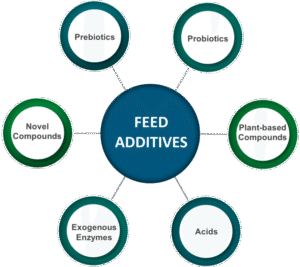The required nutrients must be available in the quantity of DM an animal is able to consume within 24 hours. If not, a ration is not considered balanced. In practice, the maximum DMI from roughage is not more than 2% of the body-weight.
Thank you for reading. Don't forget to subscribe & share!
.Minimum Roughage Intake
To avoid disturbances in functioning of the rumen, metabolic disorders and to maintaining a high butterfat level in the milk, at least 30% of the total DM in the ration should be supplied by roughage. In case high quantities of young roughage are supplied (young grass, grass and maize silage) the structure value of the ration is to be considered
Required Amount of Energy (FUM)
Under all conditions the required quantity of FUM should be supplied. In an energy-deficient ration, the animal will utilize proteins as energy.
First priority in dairy feeding is to fulfil the demand for energy. During early lactation, from calving till end of peak yield , DMI is limited (energy gap). A cow will mobilize her body-fats to fulfil the demand for energy, provided that sufficient extra protein is made available to her during this period.
.Protein Requirements
In the protein requirements, four aspects are to be considered:
.”Normal” protein requirements
2.Protein : energy ratio
3.Protein-demand during early lactation from calving till end of peak yield.
4. Quality of the proteins degradability
.”Normal” Protein Requirements
Although desirable, it is not always necessary to cover quantities of required proteins completely within a ration (provided the energy demand is completely covered). The protein may be 5-10% lower than the calculated protein. Under “normal” is understood low and medium production levels, dry periods, and in case of a slow growth rate requirements to reach the aimed bodyweight at first service.
Anyhow, a slight “under-feeding” in protein is tolerated. The condition and development of an animal is to be considered first of all.
.Energy: Protein Ratio
The ration energy: protein becomes more narrow with increasing production . Animals with a high milk production will require concentrates with a higher energy percentage than animals with a low milk production. For example, a energy: protein ratio (FUM : DCP) for maintenance + 5 kg milk is 1 : 12.1. For maintenance + 40 kg milk this is 1 : 8.2. The DCP level decreases with ± 30%!
As protein is expensive, it seems desirable (economical) to have different types of concentrates available for the requirements of the different livestock classes: high yielding, medium yielding, low yielding/dry period, as experienced through the different stages of lactation.
.Protein-demand During Early Lactation From Calving – End of Peak Yield
The cow experiences a depressed appetite during the early lactation period (first 8-12 weeks). During this period the cow is experiencing an “energy-gap”, which she will fill by mobilizing her body reserves (fats), provided she had a sufficient good condition at calving (condition- score 3-3½).
Also a “protein-gap” is experienced. The cow lacks the means to mobilize the required proteins from her body reserves. To enable a cow to mobilize her body reserves (fats) as to reach a maximum peak yield (and lactation yield!) the protein requirements have to be increased by 10-15% during this period. All required proteins are to be squeezed in the DM
a cow can eat at that moment. It seems appropriate to have a special high protein concentrate mixture available for this early lactation period, if maximum peak yield and subsequently maximum lactation yield are to be reached.
.Quality of the Proteins Degradability
The protein requirements over 13% CP (which is ± 8½ % DCP as DCP = 0.65 x CP) have to be met by undegradable proteins, also “by-pass” proteins. These are playing an important role in fulfilling the protein demands for a high milk production. The role becomes more important in rations containing high amounts of good quality grass silage or young grass, as these contain low amounts of undegradable proteins .
.Limiting Aspects of Certain Feedstuffs
Some feedstuffs contain substances/toxins, which may limit their use (molasses diarrhoea, cotton seed gossypol, some cakes high fat-contents, brassica products goitrogenic products) or contain substances influencing, e.g. taste of the milk (fish meal taste in milk), and therefore only limited amounts can be mixed in the ration. the maximum amounts of ingredients that can be used in concentrate mixtures used in rations in which more than 50% of the total ration DM is supplied by concentrates.
.Availability
Continuity of supply may be considered, when a certain ingredient is included in the formulation of the ration.









